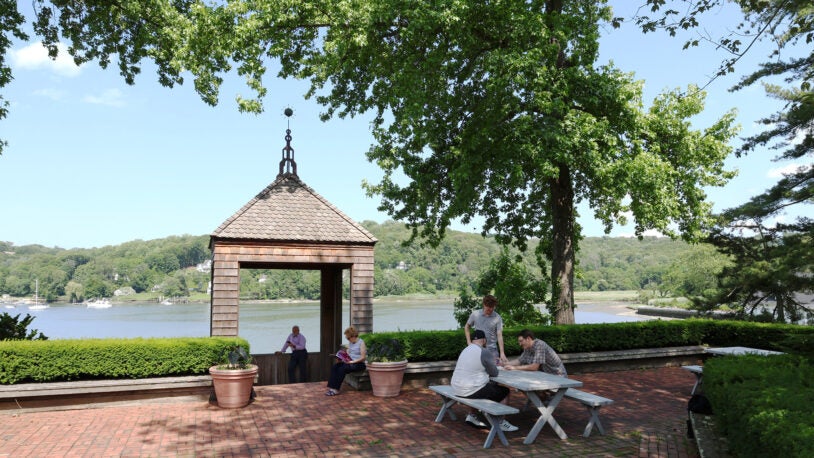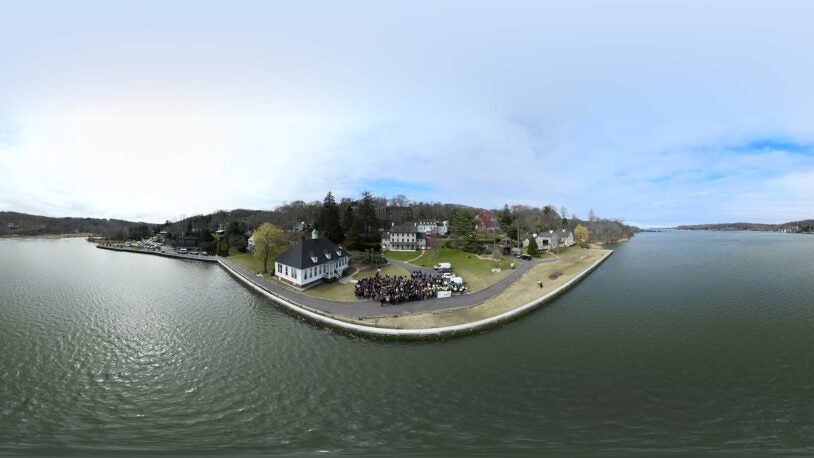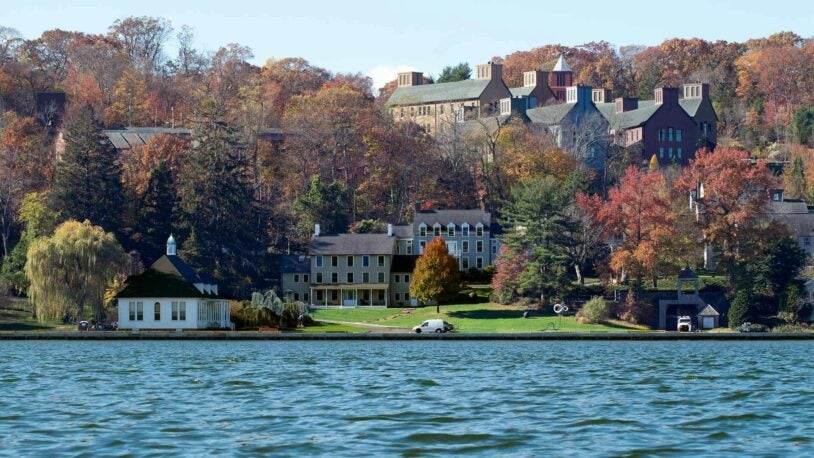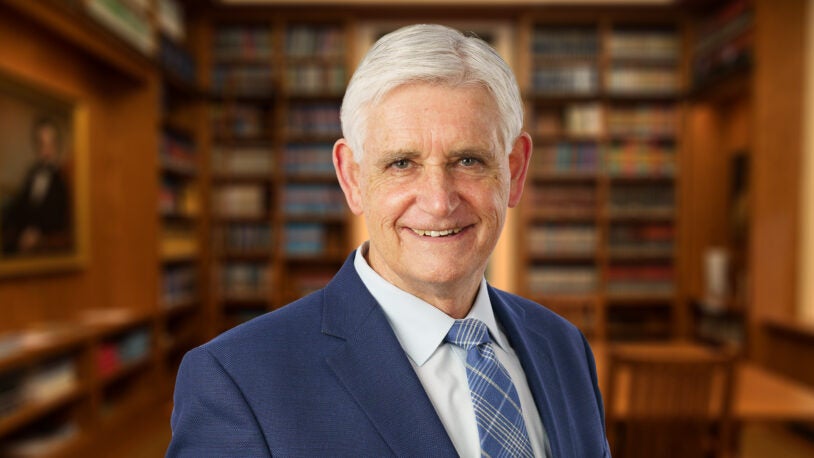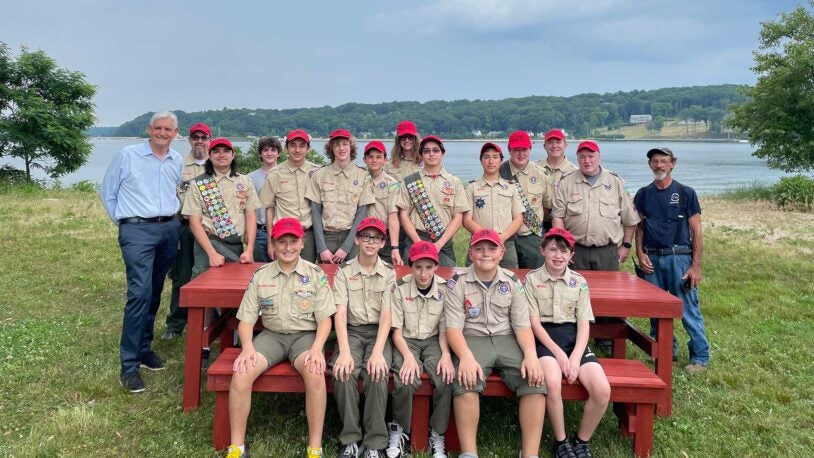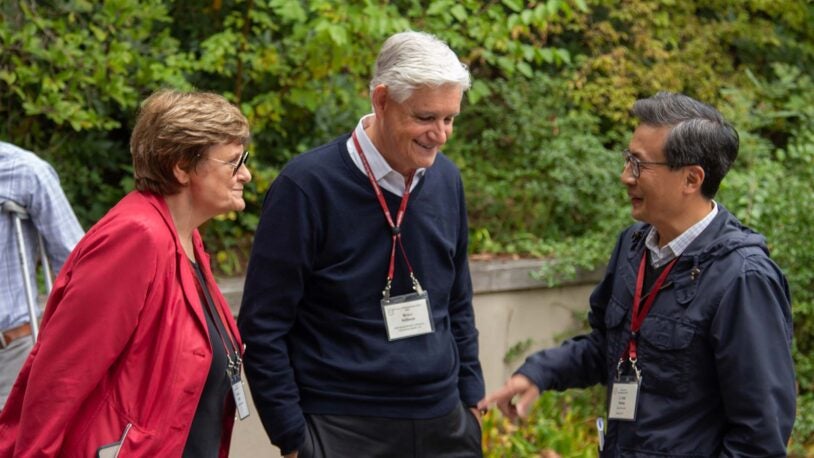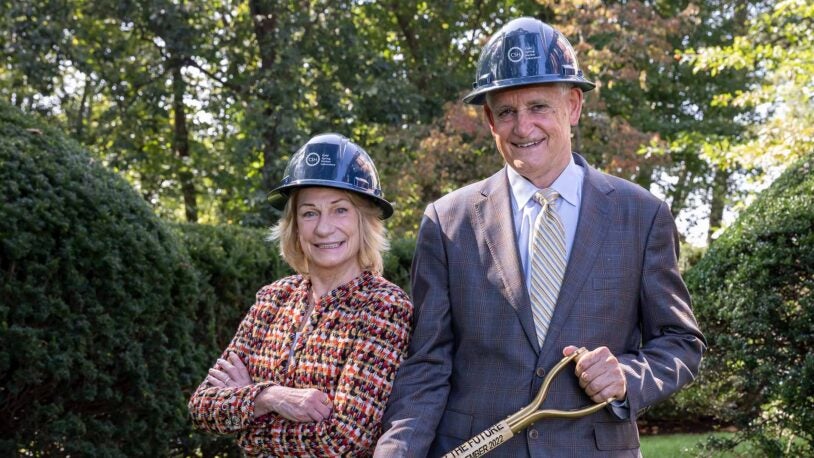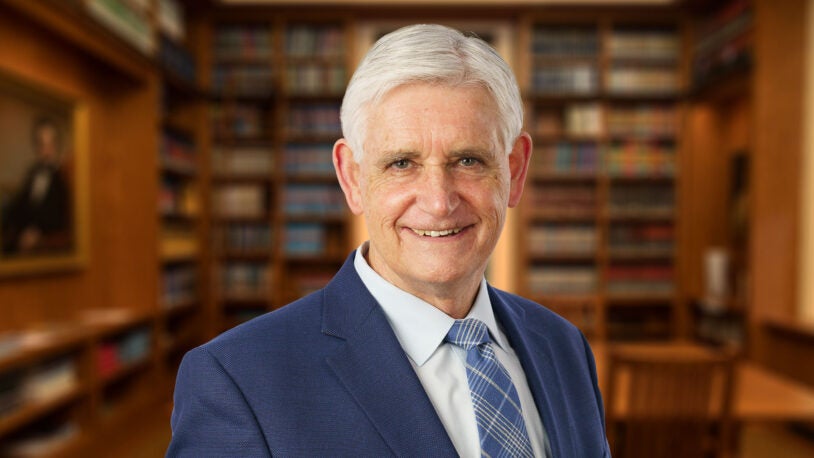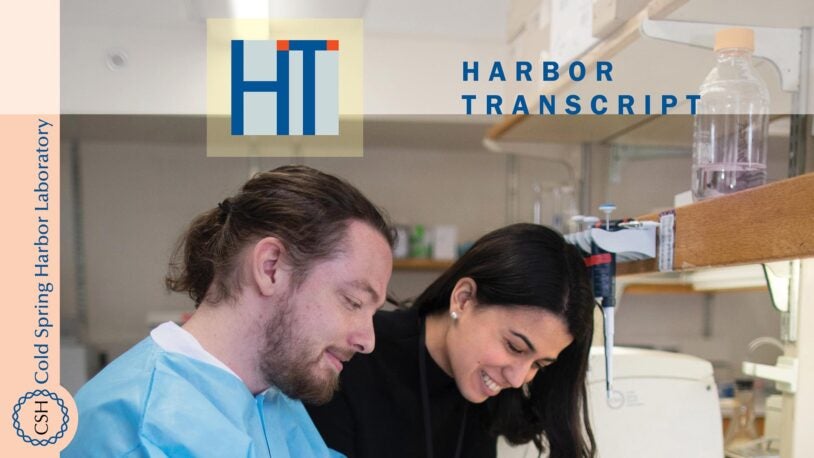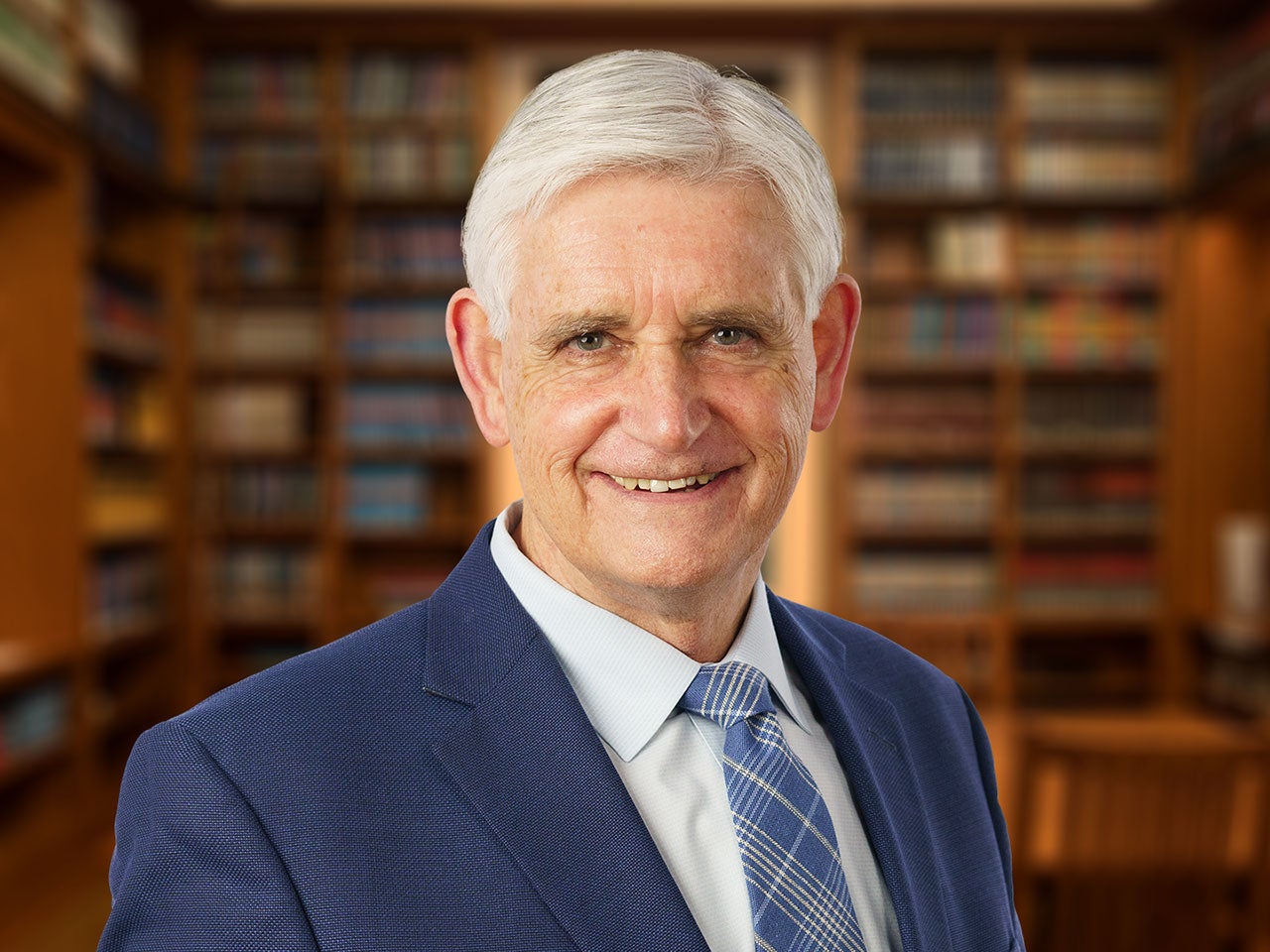
Bruce Stillman
President and Chief Executive Officer
Oliver R. Grace Professor
Cancer Center Member
Ph.D., Australian National University, 1979
stillman@cshl.edu | 516-367-8383
Every time a cell divides, it must accurately copy its DNA. With 3 billion “letters” in the human genome, this is no small task. My studies reveal the many steps and molecular actors involved, as well as how errors in DNA replication are involved in diseases that range from cancer to rare genetic disorders.
Bruce Stillman’s lab studies the process by which DNA is copied within cells before they divide in two. Working with yeast and human cells, Stillman and colleagues have identified many of the cellular proteins that function at the DNA replication fork during the S phase, the portion of the cell-division cycle when DNA synthesis occurs. Among these proteins are those that facilitate the assembly of chromatin, the protein–DNA complexes that form the chromosomes. Current research focuses on the mechanism that initiates the entire process of DNA replication in eukaryotic cells. At the heart of this mechanism is a protein that binds to “start” sites on the chromosomes, called the Origin Recognition Complex, ORC. The Stillman lab is part of an ongoing collaboration that determined the cryo-EM structure of ORC proteins in complex with a group of proteins, called a helicase, that unwind DNA during replication. These images offer molecular insights into how the helicase is loaded onto DNA. Stillman’s research also focuses on the process by which duplicated chromosomes are segregated during mitosis. They found ORC at centrosomes and centromeres, structures that orchestrate chromosome separation during mitosis. At centromeres, ORC subunits monitor the attachment of duplicated chromosomes to the mitotic spindle that pulls the chromosomes apart when they are correctly aligned. Stillman’s team has discovered that mutations in the Orc1 protein alter the ability of ORC to regulate both DNA replication and centrosome duplication. These mutations have been linked to Meier–Gorlin syndrome, a condition that results in people with extreme dwarfism and small brain size, but normal intelligence.
- CSHL President Bruce Stillman wins Heineken Prize (2020)
- Canada Gairdner International Award (with John Diffley, 2019)
- American Association for Cancer Research, Elected Fellow of the AACR Academy (2019)
- Doctor of Science, (honoris causa), Clarkson University (2018)
- Science and Technology Award, City of Suzhou, China (2018)
- National Academy of Inventors, Elected Fellow (2016)
- Herbert Tabor Research Award, American Society for Biochemistry and Molecular Biology (2014)
- Australian Academy of Science, Elected Corresponding Member (2012)
- Louisa Gross Horwitz Prize, Columbia University (with Thomas Kelly; 2010)
- American Academy of Arts and Sciences, Elected Member (2008)
- Doctor of Science (honoris causa), University of Sydney (2008)
- Doctor of Science, (honoris causa), Long Island University (2007)
- Society of Surgical Oncology – American Cancer Society Basic Science Award and Lecture (2006)
- Curtin Medal for Excellence in Medical Research, Australian National University (2006)
- American Association for the Advancement of Science, Elected Fellow (2005)
- Alfred P. Sloan Prize, General Motors Cancer Research Foundation, (with Thomas Kelly; 2004)
- Doctor of Science (honoris causa), Stony Brook University (2002)
- Doctor of Humane Letters (honoris causa), Hofstra University (2001)
- Doctor of Science (honoris causa), New York Institute of Technology (2001)
- European Molecular Biology Organization, Associate Member (2001)
- American Academy of Microbiology, Elected Fellow (2000)
- National Academy of Sciences, Elected Foreign Associate (2000); Member as of 2013
- Order of Australia, AO (1999)
- Julian Wells Medal, Lorne Genome Conference, Australia (1994)
- The Royal Society (London), Elected Fellow (1993)
The Adenovirus Gazebo
June 26, 2025
It’s not just any gazebo—it’s a meeting place, a scenic overlook, and a monument to CSHL’s decades of revolutionary genetics research.
President’s essay: We are science, and science is crucial
June 2, 2025
With public research funding under threat in the U.S., CSHL President Bruce Stillman outlines the stakes for people in our communities and abroad.
The natural evolution of bioRxiv and medRxiv
March 11, 2025
Independent nonprofit openRxiv launches to secure the long-term sustainability of biomedical research–sharing platforms bioRxiv and medRxiv.
Statement on NIH funding guidance
February 10, 2025
New NIH Guidance will severely reduce funding for research. Supporting science is an investment in our nation’s health, security, and economy.
Empowering Insights: The science behind health
November 18, 2024
“The opportunity to turn curiosity into discoveries that impact the human condition is at the core of CSHL’s mission,” writes President Stillman.
Table for 32
June 26, 2024
CSHL was excited to partner with Boy Scouts Troop 32 to help a young community member interested in science complete his Eagle Scout project.
President’s essay: The continuous cycle of discovery
May 30, 2024
CSHL President & CEO Bruce Stillman discusses our institution’s societal impacts and global connections as forces for further scientific progress.
Breaking new ground: For science and society
November 13, 2023
CSHL’s Foundations for the Future campaign will propel the institution’s bioscience research and education programs to new heights and maximal impact.
Stillman earns ASBMB Distinguished Scientist Award
September 7, 2023
The American Society for Biochemistry and Molecular Biology honored CSHL President & CEO Bruce Stillman for outstanding achievement in basic research.
Summer 2023 Harbor Transcript now online
May 31, 2023
This Special Annual Report edition of CSHL’s magazine provides a look back at some of the Laboratory’s biggest stories from 2022.
Selected Publications
The remarkable gymnastics of ORC.
9 Feb 2022 | eLife | 11
Stillman, Bruce;
The structure of ORC–Cdc6 on an origin DNA reveals the mechanism of ORC activation by the replication initiator Cdc6
23 Jun 2021 | Nature Communications | 12(1)
Feng, Xiang; Noguchi, Yasunori; Barbon, Marta; Stillman, Bruce; Speck, Christian; Li, Huilin;
Multiple, short protein binding motifs in ORC1 and CDC6 control the initiation of DNA replication
13 Mar 2021 | Molecular Cell
Hossain, Manzar; Bhalla, Kuhulika; Stillman, Bruce;
Evolution of DNA replication origin specification and gene silencing mechanisms
14 Oct 2020 | Nature Communications | 11(1):5175
Hu, Y; Tareen, A; Sheu, Y; Ireland, W; Speck, C; Li, H; Joshua-Tor, L; Kinney, J; Stillman, B;
Structure of the active form of human Origin Recognition Complex and its ATPase motor module
23 Jan 2017 | eLife | 6
Tocilj, A; On, K; Yuan, Z; Sun, J; Elkayam, E; Li, H; Stillman, B; Joshua-Tor, L;
All Publications
Genome sequence assembly and annotation of MATA and MATB strains of Yarrowia lipolytica
25 Mar 2025 | bioRxiv
Zali, Narges; El Damerash, Osama; Chougule, Kapeel; Lu, Zhenyuan; Ware, Doreen; Stillman, Bruce;
Establishing a biochemical understanding of the initiation of chromosome replication in bacteria
4 Jun 2024 | Proceedings of the National Academy of Sciences of the United States of America | 121(23):e2400667121
Stillman, Bruce;
Origins of DNA replication in eukaryotes
9 Jan 2023 | Molecular Cell | :S1097-2765(22)01203
Hu, Yixin; Stillman, Bruce;
Prevalent and dynamic binding of the cell cycle checkpoint kinase Rad53 to gene promoters
15 Dec 2022 | eLife | 11:e84320
Sheu, Yi-Jun; Kawaguchi, Risa; Gillis, Jesse; Stillman, Bruce;
Prevalent and Dynamic Binding of the Cell Cycle Checkpoint Kinase Rad53 to Gene Promoters
23 May 2021 | bioRxiv
Sheu, Yi-Jun; Kawaguchi, Risa; Gillis, Jesse; Stillman, Bruce;
Structural mechanism of helicase loading onto replication origin DNA by ORC-Cdc6 (vol 117, pg 17747, 2020)
2021 | Proceedings of the National Academy of Sciences of the United States of America | 118(6)
Yuan, Zuanning; Schneider, Sarah; Dodd, Thomas; Riera, Alberto; Bai, Lin; Yan, Chunli; Barbon, Marta; Magdalou, Indiana; Ivanov, Ivaylo; Stillman, Bruce; Li, Huilin; Speck, Christian;
The human Origin Recognition Complex is essential for pre-RC assembly, mitosis and maintenance of nuclear structure.
1 Feb 2021 | eLife | 10
Chou, Hsiang-Chen; Bhalla, Kuhulika; Demerdesh, Osama; Klingbeil, Olaf; Hanington, Kaarina; Aganezov, Sergey; Andrews, Peter; Alsudani, Habeeb; Chang, Kenneth; Vakoc, Christopher; Schatz, Michael; McCombie, W; Stillman, Bruce;
The dynamic nature of the human origin recognition complex revealed through five cryoEM structures
18 Aug 2020 | eLife | 9:e58622
Jaremko, M; On, K; Thomas, D; Stillman, B; Joshua-Tor, L;
The dynamic nature of the human Origin Recognition Complex revealed through five cryoEM structures
14 Aug 2020 | eLife
Jaremko, Matt; On, Kin; Thomas, Dennis; Stillman, Bruce; Joshua-Tor, Leemor;
The human Origin Recognition Complex is essential for pre-RC assembly, mitosis and maintenance of nuclear structure
6 Aug 2020 | bioRxiv
Chou, H; Bhalla, K; El Demerdash, O; Klingbeil, O; Hanington, Kaarina; Aganezov, S; Andrews, P; Alsudani, H; Chang, K; Vakoc, C; Schatz, M; McCombie, W; Stillman, B;
Structural mechanism of helicase loading onto replication origin DNA by ORC-Cdc6
28 Jul 2020 | Proceedings of the National Academy of Sciences of the United States of America | 117(30):17747-17756
Yuan, Zuanning; Schneider, Sarah; Dodd, Thomas; Riera, A; Bai, Lin; Yan, Chunli; Magdalou, Indiana; Ivanov, Ivaylo; Stillman, Bruce; Li, Huilin; Speck, C;
Evolution of DNA Replication Origin Specification and Gene Silencing Mechanisms
4 Jul 2020 | bioRxiv
Hu, Y; Tareen, A; Sheu, Y-J; Ireland, W; Speck, C; Li, H; Joshua-Tor, L; Kinney, J; Stillman, B;
Increasing gender diversity in the STEM research workforce.
8 Nov 2019 | Science | 366(6466):692-695
Greider, Carol; Sheltzer, Jason; Cantalupo, Nancy; Copeland, Wilbert; Dasgupta, Nilanjana; Hopkins, Nancy; Jansen, Jaclyn; Joshua-Tor, Leemor; McDowell, Gary; Metcalf, Jessica; McLaughlin, BethAnn; Olivarius, Ann; O'Shea, Erin; Raymond, Jennifer; Ruebain, David; Steitz, Joan; Stillman, Bruce; Tilghman, Shirley; Valian, Virginia; Villa-Komaroff, Lydia; Wong, Joyce;
Joseph F. Sambrook (1939-2019)
23 Sep 2019 | Nature Structural & Molecular Biology | 26(10):846-847
Dunn, A; Johnstone, R; Stillman, B;
Cyclin binding Cy motifs have multiple activities in the initiation of DNA replication
24 Jun 2019 | bioRxiv
Hossain, Manzar; Bhalla, Kuhulika; Stillman, Bruce;
Foreword
1 Jan 2019 | Cold Spring Harbor Symposia on Quantitative Biology | 84:XIX
Grodzicker, T; Stewart, D; Stillman, B;
A structural view of the initiators for chromosome replication
Dec 2018 | Current Opinion in Structural Biology | 53:131-139
On, Kin; Jaremko, Matt; Stillman, Bruce; Joshua-Tor, Leemor;
Histone Modifications: Insights into Their Influence on Gene Expression
11 Sep 2018 | Cell
Stillman, Bruce;
The dNTP triphosphohydrolase activity of SAMHD1 persists during S-phase when the enzyme is phosphorylated at T592
24 Jul 2018 | Cell Cycle | 17(9):1102-1114
Tramentozzi, E; Ferraro, P; Hossain, M; Stillman, B; Bianchi, V; Pontarin, G;
Foreword
2018 | Cold Spring Harbor Symposia on Quantitative Biology | 83:XV
Stewart, David; Stillman, Bruce;
Cryo-EM structure of Mcm2-7 double hexamer on DNA suggests a lagging-strand DNA extrusion model
7 Nov 2017 | Proceedings of the National Academy of Sciences of the United States of America | 114(45):E9529-9538
Noguchi, Y; Yuan, Z; Bai, L; Schneider, S; Zhao, G; Stillman, B; Speck, C; Li, H;
Structural basis of Mcm2-7 replicative helicase loading by ORC-Cdc6 and Cdt1
Mar 2017 | Nature Structural & Molecular Biology | 24(3):316-324
Yuan, Z; Riera, A; Bai, L; Sun, J; Nandi, S; Spanos, C; Chen, Z; Barbon, M; Rappsilber, J; Stillman, B; Speck, C; Li, H;
Key mechanism in the loading and activation of the replicative helicase MCM2-7
4 Sep 2016 | The FEBS Journal | 283:12
Speck, C; Riera, A; Yuan, Z; Sun, J; Barbon, M; Rappsilber, J; Stillman, B; Li, H;
Opposing roles for DNA replication initiator proteins ORC1 and CDC6 in control of Cyclin E gene transcription
26 Jul 2016 | eLife | 5
Hossain, M; Stillman, B;
Targeted Doxorubicin Delivery to Brain Tumors via Minicells: Proof of Principle Using Dogs with Spontaneously Occurring Tumors as a Model
6 Apr 2016 | PLoS ONE | 11(4):e0151832
MacDiarmid, J; Langova, V; Bailey, D; Pattison, S; Pattison, S; Christensen, N; Armstrong, L; Brahmbhatt, V; Smolarczyk, K; Harrison, M; Costa, M; Mugridge, N; Sedliarou, I; Grimes, N; Kiss, D; Stillman, B; Hann, C; Gallia, G; Graham, R; Brahmbhatt, H;
Concerted activities of Mcm4, Sld3 and Dbf4 in control of origin activation and DNA replication fork progression
Mar 2016 | Genome Research | 26(3):315-330
Sheu, Y; Kinney, J; Stillman, B;
Reconsidering DNA Polymerases at the Replication Fork in Eukaryotes
16 Jul 2015 | Molecular Cell | 59(2):139-141
Stillman, B;
Orc1 Binding to Mitotic Chromosomes Precedes Spatial Patterning During G1 Phase and Assembly of the Origin Recognition Complex in Human Cells
8 May 2015 | Journal of Biological Chemistry | 290(19):12355-12369
Kara, N; Hossain, M; Prasanth, S; Stillman, B;
Rhabdomyosarcoma: Current Challenges and Their Implications for Developing Therapies
1 Nov 2014 | Cold Spring Harbor Perspectives in Biology | 4(11)
Hettmer, S; Li, Z; Billin, A; Barr, F; Cornelison, D; Ehrlich, A; Guttridge, D; Hayes-Jordan, A; Helman, L; Houghton, P; Khan, J; Langenau, D; Linardic, C; Pal, R; Partridge, T; Pavlath, G; Rota, R; Schafer, B; Shipley, J; Stillman, B; Wexler, L; Wagers, A; Keller, C;
Structural and mechanistic insights into Mcm2-7 double-hexamer assembly and function
15 Oct 2014 | Genes & Development | 28(20):2291-303
Sun, J; Fernandez-Cid, A; Riera, A; Tognetti, S; Yuan, Z; Stillman, B; Speck, C; Li, H;
Acquired Dependence of Acute Myeloid Leukemia on the DEAD-Box RNA Helicase DDX5
Jun 2014 | Cell Reports | 7(6):1887-1899
Mazurek, A; Park, Y; Miething, C; Wilkinson, J; Gillis, J; Lowe, S; Vakoc, C; Stillman, B;
Domain within the helicase subunit Mcm4 integrates multiple kinase signals to control DNA replication initiation and fork progression
16 Apr 2014 | Proceedings of the National Academy of Sciences of the United States of America | 111(18):E1899-1908
Sheu, Y; Kinney, J; Lengronne, A; Pasero, P; Stillman, B;
Biochemical studies on replication of the genome in eukaryotes
Apr 2014 | The FASEB Journal | 28(1)
Stillman, B; Speck, C; Li, H;
Deoxynucleoside triphosphate (dNTP) synthesis and destruction regulate the replication of both cell and virus genomes
14 Aug 2013 | Proceedings of the National Academy of Sciences of the United States of America | 110(35):14120-14121
Stillman, B;
Cryo-EM structure of a helicase loading intermediate containing ORC-Cdc6-Cdt1-MCM2-7 bound to DNA
Aug 2013 | Nature Structural & Molecular Biology | 20(8):944-951
Sun, J; Evrin, C; Samel, S; Fernandez-Cid, A; Riera, A; Kawakami, H; Stillman, B; Speck, C; Li, H;
Immunoblotting histones from yeast whole-cell protein extracts
1 Jul 2013 | Cold Spring Harbor Protocols | 2013(7)
Rossmann, M; Stillman, B;
Principles and concepts of DNA replication in bacteria, archaea, and eukarya
Jul 2013 | Cold Spring Harbor Perspectives in Biology | 5(7)
O'Donnell, M; Langston, L; Stillman, B;
The Biology of Plants. Foreword.
2012 | Cold Spring Harbor Symposia on Quantitative Biology | 77:xv
Stillman, Bruce; Grodzicker, Terri; Martienssen, Rob; Stewart, David;
In vitro reconstitution of budding yeast pre-RC, competent in recruitment of recombinant pre-IC components, using purified, recombinant proteins
Dec 2012 | Genes and Genetic Systems | 87(6):385
Kawakami, H; Stillman, B;
DDX5 regulates DNA replication and is required for cell proliferation in a subset of breast cancer cells
2012 | Cancer Discovery | 2(9):812-825
Mazurek, A; Luo, W; Krasnitz, A; Hicks, J; Powers, R; Stillman, B;
Meier-Gorlin syndrome mutations disrupt an Orc1 CDK inhibitory domain and cause centrosome reduplication
15 Aug 2012 | Genes & Development | 26(16):1797-810
Hossain, M; Stillman, B;
The origin recognition complex: a biochemical and structural view
2012 | Sub-Cellular Biochemistry | 62:37-58
Li, H; Stillman, B; MacNeill, Stuart;
Cdc6-Induced Conformational Changes in ORC Bound to Origin DNA Revealed by Cryo-Electron Microscopy
Mar 2012 | Structure | 20(3):534-544
Sun, J; Kawakami, H; Zech, J; Speck, C; Stillman, B; Li, H;
Partial MCM4 deficiency in patients with growth retardation, adrenal insufficiency, and natural killer cell deficiency
Mar 2012 | Journal of Clinical Investigation | 122(3):821-832
Gineau, L; Cognet, C; Kara, N; Lach, F; Dunne, J; Veturi, U; Picard, C; Trouillet, C; Eidenschenk, C; Aoufouchi, S; Alcaïs, A; Smith, O; Geissmann, F; Feighery, C; Abel, L; Smogorzewska, A; Stillman, B; Vivier, E; Casanova, J; Jouanguy, E;
The Biology of Plants
2012 | Cold Spring Harbor Symposia on Quantitative Biology | 77
Stillman, B; Grodzicker, T; Martienssen, R; Stewart, D; Stillman, Bruce; Grodzicker, Terri; Martienssen, Rob; Stewart, David;
Replication-coupled chromatin assembly generates a neuronal bilateral asymmetry in C. elegans
2011 | Cell | 147(7):1525-1536
Nakano, S; Stillman, B; Horvitz, H;
Phosphorylation of H4 Ser 47 promotes HIRA-mediated nucleosome assembly
Jul 2011 | Genes & Development | 25(13):1359-1364
Kang, B; Pu, M; Hu, G; Wen, W; Dong, Z; Zhao, K; Stillman, B; Zhang, Z;
Reversible suppression of an essential gene in adult mice using transgenic RNA interference
26 Apr 2011 | Proceedings of the National Academy of Sciences of the United States of America | 108(17):7113-7118
McJunkin, K; Mazurek, A; Premsrirut, P; Zuber, J; Dow, L; Simon, J; Stillman, B; Lowe, S;
A Common Telomeric Gene Silencing Assay Is Affected by Nucleotide Metabolism
7 Apr 2011 | Molecular Cell | 42(1):127-136
Rossmann, M; Luo, W; Tsaponina, O; Chabes, A; Stillman, B;
An analysis of CAF-1 interacting proteins reveals dynamic and direct interactions with the ku complex and 14-3-3 proteins
5 Jan 2011 | Journal of Biological Chemistry | 286(12):10876-10887
Hoek, M; Myers, M; Stillman, B;
Human origin recognition complex is essential for HP1 binding to chromatin and heterochromatin organization
24 Aug 2010 | Proceedings of the National Academy of Sciences of the United States of America | 107(34):15093-8
Prasanth, S; Shen, Z; Prasanth, K; Stillman, B;
Break-induced replication requires all essential DNA replication factors except those specific for pre-RC assembly
2010 | Genes & Development | 24(11):1133-1144
Lydeard, J; Lipkin-Moore, Z; Sheu, Y; Stillman, B; Burgers, P; Haber, J;
Deciphering protein kinase specificity through large-scale analysis of yeast phosphorylation site motifs
2010 | Science Signaling | 3(109)
Mok, J; Kim, P; Lam, H; Piccirillo, S; Zhou, X; Jeschke, G; Sheridan, D; Parker, S; Desai, V; Jwa, M; Cameroni, E; Niu, H; Good, M; Remenyi, A; Ma, J; Sheu, Y; Sassi, H; Sopko, R; Chan, C; De Virgilio, C; Hollingsworth, N; Lim, W; Stern, D; Stillman, B; Andrews, B; Gerstein, M; Snyder, M; Turk, B;
The Dbf4-Cdc7 kinase promotes S phase by alleviating an inhibitory activity in Mcm4
7 Jan 2010 | Nature | 463(7277):113-117
Sheu, Y; Stillman, B; Cold Spring Harbor Laboratory;
A double-hexameric MCM2-7 complex is loaded onto origin DNA during licensing of eukaryotic DNA replication
Dec 2009 | Proceedings of the National Academy of Sciences of the United States of America | 106(48):20240-20245
Evrin, C; Clarke, P; Zech, J; Lurz, R; Sun, J; Uhle, S; Li, H; Stillman, B; Speck, C;
The elongator complex interacts with PCNA and modulates transcriptional silencing and sensitivity to DNA damage agents
16 Oct 2009 | PLoS Genetics | 5(10):e1000684
Li, Q; Fazly, A; Zhou, H; Huang, S; Zhang, Z; Stillman, B;
Sequential treatment of drug-resistant tumors with targeted minicells containing siRNA or a cytotoxic drug
28 Jun 2009 | Nature Biotechnology | 27(7):643-651
MacDiarmid, J; Amaro-Mugridge, N; Madrid-Weiss, J; Sedliarou, I; Wetzel, S; Kochar, K; Brahmbhatt, V; Phillips, L; Pattison, S; Petti, C; Stillman, B; Graham, R; Brahmbhatt, H;
Orc1 Controls Centriole and Centrosome Copy Number in Human Cells
6 Feb 2009 | Science | 323(5915):789-793
Hemerly, A; Prasanth, S; Siddiqui, K; Stillman, B;
A proposal for a coordinated effort for the determination of brainwide neuroanatomical connectivity in model organisms at a mesoscopic scale
28 Jan 2009 | PLoS Computational Biology
Bohland, Jason; Wu, Caizhi; Barbas, Helen; Bokil, Hemant; Bota, Mihail; Breiter, Hans; Cline, Hollis; Doyle, John; Freed, Peter; Greenspan, Ralph; Haber, Suzanne; Hawrylycz, Michael; Herrera, Daniel; Hilgetag, Claus; Huang, Z; Jones, Allan; Jones, Edward; Karten, Harvey; Kleinfeld, David; Kotter, Rolf; Lester, Henry; Lin, John; Mensh, Brett; Mikula, Shawn; Panksepp, Jaak; Price, Joseph; Safdieh, Joseph; Saper, Clifford; Schiff, Nicholas; Schmahmann, Jeremy; Stillman, Bruce; Svoboda, Karel; Swanson, Larry; Toga, Arthur; Essen, David; Watson, James; Mitra, Partha;
ABF1-binding Sites Promote Efficient Global Genome Nucleotide Excision Repair
Jan 2009 | Journal of Biological Chemistry | 284(2):966-973
Yu, S; Smirnova, J; Friedberg, E; Stillman, B; Akiyama, M; Owen-Hughes, T; Waters, R; Reed, S;
A proposal for a coordinated effort for the determination of brainwide neuroanatomical connectivity in model organisms at a mesoscopic scale
Mar 2009 | PLoS Computational Biology | 5(3):e1000334
Bohland, J; Wu, C; Barbas, H; Bokil, H; Bota, M; Breiter, H; Cline, H; Doyle, J; Freed, P; Greenspan, R; Haber, S; Hawrylycz, M; Herrera, D; Hilgetag, C; Huang, Z; Jones, A; Jones, E; Karten, H; Kleinfeld, D; Kotter, R; Lester, H; Lin, J; Mensh, B; Mikula, S; Panksepp, J; Price, J; Safdieh, J; Saper, C; Schiff, N; Schmahmann, J; Stillman, B; Svoboda, K; Swanson, L; Toga, A; Van Essen, D; Watson, J; Mitra, P;
The architecture of the DNA replication origin recognition complex in Saccharomyces cerevisiae
29 Jul 2008 | Proceedings of the National Academy of Sciences of the United States of America | 105(30):10326-10331
Chen, Z; Speck, C; Wendel, P; Tang, C; Stillman, B; Lill, H; Cold Spring Harbor Lab, Cold Spring Harbor, NY; Brookhaven Natl Lab, Dept Biol, Upton, NY; SUNY Stony Brook, Dept Biochem & Cell Biol, Stony Brook, NY;
DNA polymerases at the replication fork in eukaryotes
9 May 2008 | Molecular Cell | 30(3):259-60
Stillman, B;
A tribute to Arthur Kornberg 1918-2007
Jan 2008 | Nature Structural & Molecular Biology | 15(1):2-17
Fuller, R; Bambara, R; Baker, T; Funnell, B; Wahle, E; O'Donnell, M; Kaiser, D; Skarstad, K; Konforti, B; Maki, S; Katayama, T; Sekimizu, K; Weiner, J; Davis, R; Rowen, L; Goodman, M; Spudich, J; Pfeffer, S; Richardson, C; Polaczek, P; Calendar, R; Kolodner, R; Griffith, J; Stillman, B; Modrich, P; Brenner, C; Yanofsky, C;
ATP dependent assembly of the human origin recognition complex
Nov 2007 | Journal of Biological Chemistry | 282(44):32370-32383
Siddiqui, K; Stillman, B;
Initiation of DNA replication - Assembly of a molecular machine depends on origin DNA
Jul 2007 | The FEBS Journal | 274(S1):72
Speck, C; Stillman, B;
Bacterially derived 400 nm particles for encapsulation and cancer cell targeting of chemotherapeutics
May 2007 | Cancer Cell | 11(5):431-445
MacDiarmid, J; Mugridge, N; Weiss, J; Phillips, L; Burn, A; Paulin, R; Haasdyk, J; Dickson, K; Brahmbhatt, V; Pattison, S; James, A; Al Bakri, G; Straw, R; Stillman, B; Graham, R; Brahmbhatt, H;
Cdc6 ATPase activity regulates ORC center dot Cdc6 stability and the selection of specific DNA sequences as origins of DNA replication
Apr 2007 | Journal of Biological Chemistry | 282(16):11705-11714
Speck, C; Stillman, B;
The Cardiovascular System
2002 | Nursing standard : official newspaper of the Royal College of Nursing | LXVII
Stillman, B; Stewart, D; Stillman, Bruce; Stewart, David;
Constitutively high dNTP concentration inhibits cell cycle progression and the DNA damage checkpoint in yeast Saccharomyces cerevisiae
23 Jan 2007 | Proceedings of the National Academy of Sciences of the United States of America | 104(4):1183-1188
Chabes, A; Stillman, B;
Cdc7-Dbf4 phosphorylates MCM proteins via a docking site-mediated mechanism to promote S phase progression
6 Oct 2006 | Molecular Cell | 24(1):101-13
Sheu, Y; Stillman, B;
Support for the Human Cancer Genome Project
Dec 2005 | Science | 310(5754):1615
Varmus, H; Stillman, B;
ATPase-dependent cooperative binding of ORC and Cdc6 to origin DNA
Nov 2005 | Nature Structural & Molecular Biology | 12(11):965-71
Speck, C; Chen, Z; Li, H; Stillman, B;
Structural basis for origin recognition complex 1 protein-silence information regulator 1 protein interaction in epigenetic silencing
14 Jun 2005 | Proceedings of the National Academy of Sciences of the United States of America | 102(24):8519-24
Hsu, H; Stillman, B; Xu, R;
Human Orc2 localizes to centrosomes, centromeres and heterochromatin during chromosome inheritance (vol 23, pg 2651, 2004)
2005 | EMBO Journal | 24(5):1092-1093
Prasanth, S; Prasanth, K; Siddiqui, K; Spector, D; Stillman, B;
Origin recognition and the chromosome cycle
7 Feb 2005 | FEBS Letters | 579(4):877-84
Stillman, B;
The knockout mouse project
Sep 2004 | Nature Genetics | 36(9):921-924
Austin, C; Battey, J; Bradley, A; Bucan, M; Capecchi, M; Collins, F; Dove, W; Duyk, G; Dymecki, S; Eppig, J; Grieder, F; Heintz, N; Hicks, G; Insel, T; Joyner, A; Koller, B; Lloyd, K; Magnuson, T; Moore, M; Nagy, A; Pollock, J; Roses, A; Sands, A; Seed, B; Skarnes, W; Snoddy, J; Soriano, P; Stewart, D; Stewart, F; Stillman, B; Varmus, H; Varticovski, L; Verma, I; Vogt, T; von Melchner, H; Witkowski, J; Woychik, R; Wurst, W; Yancopoulos, G; Young, S; Zambrowicz, B;
Human Orc2 localizes to centrosomes, centromeres and heterochromatin during chromosome inheritance
7 Jul 2004 | EMBO Journal | 23(13):2651-63
Prasanth, S; Prasanth, K; Siddiqui, K; Spector, D; Stillman, B;
Deregulation of cyclin E in human cells interferes with prereplication complex assembly
Jun 2004 | Journal of Cell Biology | 165(6):789-800
Ekholm-Reed, S; Mendez, J; Tedesco, D; Zetterberg, A; Stillman, B; Reed, S;
Dynamics of pre-replication complex proteins during the cell division cycle
29 Jan 2004 | Philosophical Transactions of the Royal Society of London. Biological Sciences | 359(1441):7-16
Prasanth, S; Mendez, J; Prasanth, K; Stillman, B;
Perpetuating the double helix: molecular machines at eukaryotic DNA replication origins
Dec 2003 | BioEssays | 25(12):1158-1167
Mendez, J; Stillman, B;
Biochemical characterization of DNA damage checkpoint complexes: Clamp loader and clamp complexes with specificity for 5' recessed DNA
Nov 2003 | PLoS Biology | 1(2):231-243
Ellison, V; Stillman, B;
Chromatin assembly factor 1 is essential and couples chromatin assembly to DNA replication in vivo
Oct 2003 | Proceedings of the National Academy of Sciences of the United States of America | 100(21):12183-12188
Hoek, M; Stillman, B;
ORC, a replication initiator protein required for multiple aspects of cell division cycle
Nov 2002 | Molecular Biology of the Cell | 13:282A
Prasanth, S; Prasanth, K; Stillman, B;
Structure and function of the BAH-containing domain of Orc1p in epigenetic silencing
Sep 2002 | EMBO Journal | 21(17):4600-4611
Zhang, Z; Hayashi, M; Merkel, O; Stillman, B; Xu, R;
Orc6 involved in DNA replication, chromosome segregation, and cytokinesis
9 Aug 2002 | Science | 297(5583):1026-31
Prasanth, S; Prasanth, K; Stillman, B;
Yph1p, an ORC-interacting protein: Potential links between cell proliferation control, DNA replication, and ribosome biogenesis
Jun 2002 | Cell | 109(7):835-848
Du, Y; Stillman, B;
Functions of sensor 1 and sensor 2 regions of Saccharomyces cerevisiae Cdc6p in vivo and in vitro
May 2002 | Journal of Biological Chemistry | 277(18):16033-16040
Takahashi, N; Tsutsumi, S; Tsuchiya, T; Stillman, B; Mizushima, T;
Biotechnology on Long Island
20 Jan 2002 | Newsday
Stillman, B;
Human origin recognition complex large subunit is degraded by ubiquitin-mediated proteolysis after initiation of DNA replication
Mar 2002 | Molecular Cell | 9(3):481-491
Mendez, J; Zou-Yang, X; Kim, S; Hidaka, M; Tansey, W; Stillman, B;
The cardiovascular system - Foreword
2002 | Cold Spring Harbor Symposia on Quantitative Biology | 67:XVII
Stillman, B;
DNA replication - Genomic views of genome duplication
Dec 2001 | Science | 294(5550):2301-2304
Stillman, B;
Identification and characterization of ORC-interacting protein: Yph1p in Saccharomyces cerevisiae
Nov 2001 | Clinical Cancer Research | 7(11):3793S
Du, N; Stillman, B;
Binding of cyclin-dependent kinases to ORC and Cdc6p regulates the chromosome replication cycle
Sep 2001 | Proceedings of the National Academy of Sciences of the United States of America | 98(20):11211-11217
Weinreich, M; Liang, C; Chen, H; Stillman, B;
Opening of the clamp: An intimate view of an ATP-driven biological machine
Sep 2001 | Cell | 106(6):655-660
Ellison, V; Stillman, B;
The stem cell decision: is this human?
15 Jul 2001 | Newsday | :B4
Stillman, B;
Human-Saccharomyces cerevisiae proliferating cell nuclear antigen hybrids - Oligomeric structure and functional characterization using in vitro DNA replication
Mar 2001 | Journal of Biological Chemistry | 276(13):10168-10177
Ola, A; Waga, S; Ellison, V; Stillman, B; McGurk, M; Leigh, I; Waseem, N; Waseem, A;
FASCIATA genes for chromatin assembly factor-1 in Arabidopsis maintain the cellular organization of apical meristems
Jan 2001 | Cell | 104(1):131-142
Kaya, H; Shibahara, K; Taoka, K; Iwabuchi, M; Stillman, B; Araki, T;
The N-terminal domains of histones H3 and H4 are not necessary for chromatin assembly factor-I-mediated nucleosome assembly onto replicated DNA in vitro
1 Jan 2001 | Chemtracts | 14(3):159-165
Shibahara, K; Verreault, A; Stillman, B; Annunziato, A;
Chromatin association of human origin recognition complex, Cdc6, and minichromosome maintenance proteins during the cell cycle: Assembly of prereplication complexes in late mitosis
Nov 2000 | Molecular and Cellular Biology | 20(22):8602-8612
Mendez, J; Stillman, B;
PCNA connects DNA replication to epigenetic inheritance in yeast
Nov 2000 | Nature | 408(6809):221-225
Zhang, Z; Shibahara, K; Stillman, B;
The N-terminal domains of histones H3 and H4 are not necessary for chromatin assembly factor-1-mediated nucleosome assembly onto replicated DNA in vitro
Jul 2000 | Proceedings of the National Academy of Sciences of the United States of America | 97(14):7766-7771
Shibahara, K; Verreault, A; Stillman, B;
Cdc6p modulates the structure and DNA binding activity of the origin recognition complex in vitro
Jul 2000 | Genes & Development | 14(13):1631-1641
Mizushima, T; Takahashi, N; Stillman, B;
Assembly of a complex containing Cdc45p, replication protein A, and Mcm2p at replication origins controlled by S-phase cyclin-dependent kinases and Cdc7p-Dbf4p kinase.
May 2000 | Molecular and Cellular Biology | 20(9):3086-3096
Zou, L; Stillman, B;
Assembly of a complex containing Cdc45p, replication protein A, and Mcm2p at replication origins controlled by S-phase cyclin-dependent kinases and Cdc7p-Dbf4p kinase
May 2000 | Molecular and Cellular Biology | 20(9):3086-3096
Zou, L; Stillman, B;
A double-hexamer archaeal minichromosome maintenance protein is an ATP-dependent DNA helicase
Feb 2000 | Proceedings of the National Academy of Sciences of the United States of America | 97(4):1530-1535
Chong, J; Hayashi, M; Simon, M; Xu, R; Stillman, B;
Yeast autonomously replicating sequence binding factor is involved in nucleotide excision repair
1 Dec 1999 | Genes & Development | 13(23):3052-3058
Reed, S; Akiyama, M; Stillman, B; Friedberg, E;
Cdc7p-Dbf4p kinase binds to chromatin during S phase and is regulated by both the APC and the RAD53 checkpoint pathway
1 Oct 1999 | EMBO Journal | 18(19):5334-46
Weinreich, M; Stillman, B;
Histone acetyltransferase HBO1 interacts with the ORC1 subunit of the human initiator protein
13 Aug 1999 | Journal of Biological Chemistry | 274(33):23027-34
Iizuka, M; Stillman, B;
Replication-dependent marking of DNA by PCNA facilitates CAF-1-coupled inheritance of chromatin
19 Feb 1999 | Cell | 96(4):575-85
Shibahara, K; Stillman, B;
The Cdc6p nucleotide-binding motif is required for loading mcm proteins onto chromatin
19 Jan 1999 | Proceedings of the National Academy of Sciences of the United States of America | 96(2):441-6
Weinreich, M; Liang, C; Stillman, B;
Heterochromatin Dynamics in Mouse Cells: Interaction between Chromatin Assembly Factor 1 and HP1 Proteins
1999 | Molecular Cell | 4(4):529-540
Murzina, N; Verreault, A; Laue, E; Stillman, B;
The Orc4p and Orc5p Subunits of the Xenopus and Human Origin Recognition Complex Are Related to Orc1p and Cdc6p
4 Dec 1998 | Journal of Biological Chemistry | 273(49):32421-32429
Tugal, T; Zou-Yang, X; Gavin, K; Pappin, D; Canas, B; Kobayashi, R; Hunt, T; Stillman, B;
The DNA replication fork in eukaryotic cells
1998 | Annual Review of Biochemistry | 67:721-51
Waga, S; Stillman, B;
Formation of a preinitiation complex by S-phase cyclin CDK-dependent loading of Cdc45p onto chromatin
24 Apr 1998 | Science | 280(5363):593-6
Zou, L; Stillman, B;
Cdc6 is regulated by E2F and is essential for DNA replication in mammalian cells
31 Mar 1998 | Proceedings of the National Academy of Sciences of the United States of America | 95(7):3603-3608
Yan, Z; DeGregori, J; Shohet, R; Leone, G; Stillman, B; Nevins, J; Williams, R;
Reconstitution of recombinant human replication factor C (RFC) and identification of an RFC subcomplex possessing DNA-dependent ATPase activity
6 Mar 1998 | Journal of Biological Chemistry | 273(10):5979-87
Ellison, V; Stillman, B;
Activation of Chromosomal DNA Replication in Saccharomyces cerevisiae by Acidic Transcriptional Activation Domains
1 Mar 1998 | Molecular and Cellular Biology | 18(3):1296-1302
Li, R; Yu, D; Tanaka, M; Zheng, L; Berger, S; Stillman, B;
Nucleosomal DNA regulates the core-histone-binding subunit of the human Hat1 acetyltransferase
15 Jan 1998 | Current Biology | 8(2):96-108
Verreault, A; Kaufman, P; Kobayashi, R; Stillman, B;
Cyclin-dependent kinase inhibitor p21 modulates the DNA primer-template recognition complex
Jul 1998 | Molecular and Cellular Biology | 18(7):4177-87
Waga, S; Stillman, B;
Cellular proteins required for adeno-associated virus DNA replication in the absence of adenovirus coinfection
Apr 1998 | Journal of Virology | 72(4):2777-87
Ni, T; McDonald, W; Zolotukhin, I; Melendy, T; Waga, S; Stillman, B; Muzyczka, N;
Cold Spring Harbor Symposia on Quantitative Biology - Volume LXIII - Mechanisms of transcription - Foreword
1998 | Cold Spring Harbor Symposia on Quantitative Biology | 63:XXIII-XXIV
Stillman, B;
Persistent initiation of DNA replication and chromatin-bound MCM proteins during the cell cycle in cdc6 mutants
15 Dec 1997 | Genes & Development | 11(24):3375-86
Liang, C; Stillman, B;
Cell cycle control of the initiation of genome replication.
1997 | The FASEB Journal | 11(9):A1015
Stillman, B; Chong, J; Liang, C; Rao, H; Weinreich, M; Zou, L;
Inhibition of CDK activity and PCNA-dependent DNA replication by p21 is blocked by interaction with the HPV-16 E7 oncoprotein
15 Aug 1997 | Genes & Development | 11(16):2090-2100
Funk, J; Waga, S; Harry, J; Espling, E; Stillman, B; Galloway, D;
Ultraviolet radiation sensitivity and reduction of telomeric silencing in Saccharomyces cerevisiae cells lacking chromatin assembly factor-I
1 Feb 1997 | Genes & Development | 11(3):345-57
Kaufman, P; Kobayashi, R; Stillman, B;
p62(dok): a constitutively tyrosine-phosphorylated, GAP-associated protein in chronic myelogenous leukemia progenitor cells
24 Jan 1997 | Cell | 88(2):197-204
Carpino, N; Wisniewski, D; Strife, A; Marshak, D; Kobayashi, R; Stillman, B; Clarkson, B;
A human protein related to yeast Cdc6p
7 Jan 1997 | Proceedings of the National Academy of Sciences of the United States of America | 94(1):142-7
Williams, R; Shohet, R; Stillman, B;
p53-induced p21 controls DNA replication
Apr 1997 | Leukemia | 11 Sup:321-3
Waga, S; Li, R; Stillman, B;
CDC45, a novel yeast gene that functions with the origin recognition complex and Mcm proteins in initiation of DNA replication
Feb 1997 | Molecular and Cellular Biology | 17(2):553-63
Zou, L; Mitchell, J; Stillman, B;
Cell cycle control of DNA replication
6 Dec 1996 | Science | 274(5293):1659-64
Stillman, B;
Nucleosome assembly by a complex of CAF-1 and acetylated histones H3/H4
4 Oct 1996 | Cell | 87(1):95-104
Verreault, A; Kaufman, P; Kobayashi, R; Stillman, B;
Chromatin assembly coupled to DNA repair: a new role for chromatin assembly factor I
20 Sep 1996 | Cell | 86(6):887-96
Gaillard, P; Martini, E; Kaufman, P; Stillman, B; Moustacchi, E; Almouzni, G;
Simian virus 40 large T antigen binds to topoisomerase I
15 Aug 1996 | Virology | 222(2):365-74
Simmons, D; Melendy, T; Usher, D; Stillman, B;
Chromosomes and expression mechanisms
1 Apr 1996 | Current Opinion in Genetics and Development | 6(2):139-40
Green, M; Stillman, B;
Postreplicative chromatin assembly by Drosophila and human chromatin assembly factor 1
1 Mar 1996 | Molecular and Cellular Biology | 16(3):810-817
Kamakaka, R; Bulger, M; Kaufman, P; Stillman, B; Kadonaga, J;
Subcellular distribution of p21 and PCNA in normal and repair-deficient cells following DNA damage
1996 | Current Biology | 6(2):189-199
Li, Rong; Hannon, G; Beach, D; Stillman, B;
Two lives in science: the scientist-administrator
1996 | The Journal of NIH Research | 8:31-32
Stillman, B;
Human and xenopus proteins related to the yeast CDC6/CDC18+ regulators of DNA replication.
1996 | Journal of Investigative Medicine | 44(3):A198
Williams, R; Stillman, B;
Cold Spring Harbor Symposia on Quantitative Biology - Volume LXI - Function & dysfunction in the nervous system - Foreword
1996 | Cold Spring Harbor Symposia on Quantitative Biology | 61:R17-R18
Stillman, B;
Conserved initiator proteins in eukaryotes
8 Dec 1995 | Science | 270(5242):1667-71
Gavin, K; Hidaka, M; Stillman, B;
The multidomain structure of Orc1p reveals similarity to regulators of DNA replication and transcriptional silencing
17 Nov 1995 | Cell | 83(4):563-8
Bell, S; Mitchell, J; Leber, J; Kobayashi, R; Stillman, B;
Cold Spring Harbor Laboratory
Nov 1995 | Molecular Medicine | 1(7):715-7
Stillman, B;
The p150 and p60 subunits of chromatin assembly factor I: a molecular link between newly synthesized histones and DNA replication
30 Jun 1995 | Cell | 81(7):1105-14
Kaufman, P; Kobayashi, R; Kessler, N; Stillman, B;
ORC and Cdc6p interact and determine the frequency of initiation of DNA replication in the genome
2 Jun 1995 | Cell | 81(5):667-76
Liang, C; Weinreich, M; Stillman, B;
The origin recognition complex interacts with a bipartite DNA binding site within yeast replicators
14 Mar 1995 | Proceedings of the National Academy of Sciences of the United States of America | 92(6):2224-8
Rao, H; Stillman, B;
Characterization of the five replication factor C genes of Saccharomyces cerevisiae
Sep 1995 | Molecular and Cellular Biology | 15(9):4661-71
Cullmann, G; Fien, K; Kobayashi, R; Stillman, B;
Identification of eukaryotic DNA replication proteins using simian virus 40 in vitro replication system
1995 | Methods in Enzymology | 262:522-548
Brush, G; Kelly, T; Stillman, B;
The origin recognition complex in silencing, cell cycle progression, and DNA replication
Jun 1995 | Molecular and Cellular Biology | 6(6):741-56
Loo, S; Fox, C; Rine, J; Kobayashi, R; Stillman, B; Bell, S;
Differential effects by the p21 CDK inhibitor on PCNA-dependent DNA replication and repair
1994 | Nature | 371(6497):534-537
Li, R; Waga, S; Hannon, G; Beach, D; Stillman, B;
Smart machines at the DNA replication fork
9 Sep 1994 | Cell | 78(5):725-8
Stillman, B;
Replicator dominance in a eukaryotic chromosome
15 Jul 1994 | EMBO Journal | 13(14):3395-400
Marahrens, Y; Stillman, B;
The p21 inhibitor of cyclin-dependent kinases controls DNA replication by interaction with PCNA
1994 | Nature | 369(6481):574-578
Waga, S; Hannon, G; Beach, D; Stillman, B;
Anatomy of a DNA replication fork revealed by reconstitution of SV40 DNA replication in vitro
19 May 1994 | Nature | 369(6477):207-12
Waga, S; Stillman, B;
Reconstitution of complete SV40 DNA replication with purified replication factors
8 Apr 1994 | Journal of Biological Chemistry | 269(14):10923-34
Waga, S; Bauer, G; Stillman, B;
Initiation of Eukaryotic DNA-Replication
Apr 1994 | The FASEB Journal | 8(7):A1323
Stillman, B;
Initiation of chromosomal DNA replication in eukaryotes. Lessons from lambda
11 Mar 1994 | Journal of Biological Chemistry | 269(10):7047-50
Stillman, B;
Coordination of Transcription and Pre-Messenger-Rna Splicing within the Cell-Nucleus
Feb 1994 | Journal of Cellular Biochemistry | 56(S18C):85
Spector, D; O'Keefe, R; Landon, S; Jimenez Garcia, L;
Functional conservation of multiple elements in yeast chromosomal replicators
Nov 1994 | Molecular and Cellular Biology | 14(11):7643-51
Rao, H; Marahrens, Y; Stillman, B;
Cloning, Expression, and Chromosomal Localization of the 140-Kilodalton Subunit of Replication Factor-C from Mice and Humans
Mar 1994 | Molecular and Cellular Biology | 14(3):1626-1634
Luckow, B; Bunz, F; Stillman, B; Lichter, P; Schutz, G;
Chromosomes and expression mechanisms: Editorial overview
1994 | Current Opinion in Genetics and Development | 4(2):183-184
Green, M; Stillman, B;
Simian virus 40 origin- and T-antigen-dependent DNA replication with Drosophila factors in vitro
Aug 1994 | Molecular and Cellular Biology | 14(8):5114-22
Kamakaka, R; Kaufman, P; Stillman, B; Mitsis, P; Kadonaga, J;
59Th Cold-Spring-Harbor Symposium On Quantitative Biology - The Molecular Genetics Of Cancer - Foreword
1994 | Cold Spring Harbor Symposia on Quantitative Biology | 59:R19
Stillman, B;
Yeast origin recognition complex functions in transcription silencing and DNA replication
17 Dec 1993 | Science | 262(5141):1844-9
Bell, S; Kobayashi, R; Stillman, B;
DNA replication: Replicator renaissance
1993 | Nature | 366(6455):506-507
Stillman, B;
cDNAs encoding the large subunit of human replication factor C
1 Dec 1993 | Proceedings of the National Academy of Sciences of the United States of America | 90(23):11014-8
Bunz, F; Kobayashi, R; Stillman, B;
Initiation of Virus and Cell-DNA Replication
Mar 1993 | Journal of Cellular Biochemistry | 53(17D):6
Stillman, B; Bell, S; Fien, K; Marahrens, Y; Melendy, T; Rao, H; Ruppert, J; Waga, S;
An interaction between replication protein A and SV40 T antigen appears essential for primosome assembly during SV40 DNA replication
15 Feb 1993 | Journal of Biological Chemistry | 268(5):3389-95
Melendy, T; Stillman, B;
Analysis of a protein-binding domain of p53
Jun 1993 | Molecular and Cellular Biology | 13(6):3811-20
Ruppert, J; Stillman, B;
The replicon model and eukaryotic chromosomes
1993 | Cold Spring Harbor Symposia on Quantitative Biology | 58:435-442
Bell, S; Marahrens, Y; Rao, H; Stillman, B;
The DNA-Binding Domain of Simian Virus-40 Tumor-Antigen Has Multiple Functions
Dec 1993 | Journal of Virology | 67(12):7608-7611
Wun-Kim, K; Upson, R; Young, W; Melendy, T; Stillman, B; Simmons, D;
ATP-dependent recognition of eukaryotic origins of DNA replication by a multiprotein complex
14 May 1992 | Nature | 357(6374):128-34
Bell, S; Stillman, B;
DNA binding properties of an HMG1-related protein from yeast mitochondria
15 Feb 1992 | Journal of Biological Chemistry | 267(5):3368-74
Diffley, J; Stillman, B;
A yeast chromosomal origin of DNA replication defined by multiple functional elements
14 Feb 1992 | Science | 255(5046):817-23
Marahrens, Y; Stillman, B;
cdc2 family kinases phosphorylate a human cell DNA replication factor, RPA, and activate DNA replication
Jun 1992 | EMBO Journal | 11(6):2189-99
Dutta, A; Stillman, B;
Identification of replication factor C from Saccharomyces cerevisiae: a component of the leading-strand DNA replication complex
Jan 1992 | Molecular and Cellular Biology | 12(1):155-63
Fien, K; Stillman, B;
Initiation of chromosome replication in eukaryotic cells
1993 | Harvey lectures | 88:115-140
Stillman, B;
DNA replication and the cell cycle.
1992 | Ciba Foundation symposium | 170:147-156
Stillman, B; Bell, S; Dutta, A; Marahrens, Y;
A Single-Stranded-DNA Binding-Protein Required for Mitochondrial-DNA Replication in Saccharomyces-Cerevisiae Is Homologous to Escherichia-Coli Ssb
Sep 1992 | EMBO Journal | 11(9):3421-3430
Van Dyck, E; Foury, F; Stillman, B; Brill, S;
DNA replication and the cell cycle
1992 | Ciba Foundation symposium | 170:147-156; discussion 156
Stillman, B; Bell, S; Dutta, A; Marahrens, Y;
DNA-Replication in Human and Yeast-Cells
Jan 1992 | The FASEB Journal | 6(1):A538
Brill, S; Stillman, B;
The Cell Surface - Foreword
1992 | Cold Spring Harbor Symposia on Quantitative Biology | 57:R17
Stillman, B;
A close relative of the nuclear, chromosomal high-mobility group protein HMG1 in yeast mitochondria
1 Sep 1991 | Proceedings of the National Academy of Sciences of the United States of America | 88(17):7864-8
Diffley, J; Stillman, B;
Immunological characterization of chromatin assembly factor I, a human cell factor required for chromatin assembly during DNA replication in vitro
25 Jun 1991 | Journal of Biological Chemistry | 266(18):12041-12047
Smith, S; Stillman, B;
The Role of the Human Rel Oncogene Product in Control of Transcription by the Human Immunodeficiency Virus Long-Terminal Repeat Hiv1-Ltr Kappab Elements
1991 | Journal of Cellular Biochemistry | 47(Suppl ):58
Li, Y; Lee, J; Mak, G; Ross, J; Franza, B;
Replication factors required for SV40 DNA replication in vitro. I. DNA structure-specific recognition of a primer-template junction by eukaryotic DNA polymerases and their accessory proteins
25 Jan 1991 | Journal of Biological Chemistry | 266(3):1950-60
Tsurimoto, T; Stillman, B;
Replication factors required for SV40 DNA replication in vitro. II. Switching of DNA polymerase alpha and delta during initiation of leading and lagging strand synthesis
25 Jan 1991 | Journal of Biological Chemistry | 266(3):1961-8
Tsurimoto, T; Stillman, B;
Purification of DNA polymerase delta as an essential simian virus 40 DNA replication factor
25 Jan 1991 | Journal of Biological Chemistry | 266(3):1942-9
Melendy, T; Stillman, B;
Replication factor-A from Saccharomyces cerevisiae is encoded by three essential genes coordinately expressed at S phase
Sep 1991 | Genes & Development | 5(9):1589-600
Brill, S; Stillman, B;
Stepwise assembly of chromatin during DNA replication in vitro
Apr 1991 | EMBO Journal | 10(4):971-80
Smith, S; Stillman, B;
Phosphorylation of replication protein A: A role for cdc2 kinase in G1/S regulation
1991 | Cold Spring Harbor Symposia on Quantitative Biology | 56:315-324
Dutta, A; Din, S; Brill, S; Stillman, B;
Sequential initiation of lagging and leading strand synthesis by two different polymerase complexes at the SV40 DNA replication origin
9 Aug 1990 | Nature | 346(6284):534-9
Tsurimoto, T; Melendy, T; Stillman, B;
Drosophila Proliferating Cell Nuclear Antigen - Structural and Functional Homology with Its Mammalian Counterpart
Jul 1990 | Journal of Biological Chemistry | 265(20):11948-11954
Ng, L; Prelich, G; Anderson, C; Stillman, B; Fisher, P;
The Initiation of Chromosomal DNA Replication in Eukaryotes
Dec 1990 | Trends in Genetics | 6(12):427-432
Diffley, J; Stillman, B;
Functions of replication factor C and proliferating-cell nuclear antigen: functional similarity of DNA polymerase accessory proteins from human cells and bacteriophage T4
Feb 1990 | Proceedings of the National Academy of Sciences of the United States of America | 87(3):1023-7
Tsurimoto, T; Stillman, B;
Cell-cycle-regulated phosphorylation of DNA replication factor A from human and yeast cells
Jun 1990 | Genes & Development | 4(6):968-77
Din, S; Brill, S; Fairman, M; Stillman, B;
Ars Binding Factors in DNA Replication and Transcriptional Silencing
1990 | Yeast | 6(SPEC. ):S12
Diffley, J; Stillman, B;
Multiple replication factors augment DNA synthesis by the two eukaryotic DNA polymerases, alpha and delta
1 Dec 1989 | EMBO Journal | 8(12):3883-9
Tsurimoto, T; Stillman, B;
Similarity between the transcriptional silencer binding proteins ABF1 and RAP1
24 Nov 1989 | Science | 246(4933):1034-8
Diffley, J; Stillman, B;
Yeast replication factor-A functions in the unwinding of the SV40 origin of DNA replication
2 Nov 1989 | Nature | 342(6245):92-5
Brill, S; Stillman, B;
Transcriptional Silencing and Lamins
Nov 1989 | Nature | 342(6245):24
Diffley, J; Stillman, B;
Purification and characterization of CAF-I, a human cell factor required for chromatin assembly during DNA replication in vitro
Jul 1989 | Cell | 58(1):15-25
Smith, S; Stillman, B;
Atrial Hyperplasia in Transgenic Mice
27 Mar 1989 | Journal of cellular biochemistry. Supplement | 41(Supple):178
Field, L; Steinhelper, M;
Production of simian virus 40 large tumor antigen in bacteria: altered DNA-binding specificity and dna-replication activity of underphosphorylated large tumor antigen
Sep 1989 | Proceedings of the National Academy of Sciences of the United States of America | 86(17):6479-83
Mohr, I; Gluzman, Y; Fairman, M; Strauss, M; McVey, D; Stillman, B; Gerard, R;
Large T-antigen mutants define multiple steps in the initiation of simian virus 40 DNA replication
Oct 1989 | Journal of Virology | 63(10):4181-8
Mohr, I; Fairman, M; Stillman, B; Gluzman, Y;
Simian virus 40 DNA replication in vitro: identification of multiple stages of initiation
Sep 1989 | Molecular and Cellular Biology | 9(9):3839-49
Tsurimoto, T; Fairman, M; Stillman, B;
Initiation of eukaryotic DNA replication in vitro
1989 | Annual review of cell biology | 5:197-245
Stillman, B;
Purification of a cellular replication factor, RF-C, that is required for coordinated synthesis of leading and lagging strands during simian virus 40 DNA replication in vitro
Feb 1989 | Molecular and Cellular Biology | 9(2):609-19
Tsurimoto, T; Stillman, B;
Purification and Characterization of a Replication-Dependent Chromatin Assembly Factor Isolated from Human Cells
1989 | Journal of Cellular Biochemistry - Supplement.(13 PART D) | :173
Smith, S; Stillman, B;
Identification of cellular components required for SV40 DNA replication in vitro
20 Dec 1988 | Biochimica et Biophysica Acta: international journal of biochemistry and biophysics | 951(2-3):382-7
Fairman, M; Prelich, G; Tsurimoto, T; Stillman, B;
Purification of a yeast protein that binds to origins of DNA replication and a transcriptional silencer
Apr 1988 | Proceedings of the National Academy of Sciences of the United States of America | 85(7):2120-4
Diffley, J; Stillman, B;
Coordinated leading and lagging strand synthesis during SV40 DNA replication in vitro requires PCNA
8 Apr 1988 | Cell | 53(1):117-26
Prelich, G; Stillman, B;
Role of the adenovirus E1B 19,000-dalton tumor antigen in regulating early gene expression
Sep 1988 | Journal of Virology | 62(9):3445-54
White, E; Denton, A; Stillman, B;
Cellular factors required for multiple stages of SV40 DNA replication in vitro
Apr 1988 | EMBO Journal | 7(4):1211-8
Fairman, M; Stillman, B;
Initiation of eukaryotic DNA replication in vitro
Aug 1988 | BioEssays | 9(2-3):56-60
Stillman, B;
Nuclear-DNA Synthesis Invitro Is Mediated Via Stable Replication Forks Assembled in a Temporally Specific Fashion In vivo
May 1988 | Molecular and Cellular Biology | 8(5):1923-1931
Heintz, N; Stillman, B;
Identification of multiple cellular factors required for SV40 replication in vitro
15 Dec 1987 | Philosophical Transactions of the Royal Society of London. Biological Sciences | 317(1187):495-505
Fairman, M; Prelich, G; Stillman, B;
Functional identity of proliferating cell nuclear antigen and a DNA polymerase-delta auxiliary protein
2 Apr 1987 | Nature | 326(6112):517-20
Prelich, G; Tan, C; Kostura, M; Mathews, M; So, A; Downey, K; Stillman, B;
The cell-cycle regulated proliferating cell nuclear antigen is required for SV40 DNA replication in vitro
2 Apr 1987 | Nature | 326(6112):471-475
Prelich, G; Kostura, M; Marshak, D; Mathews, M; Stillman, B;
Regulation of Adenovirus Early Gene-Expression by the E1b 19k Tumor-Antigen
1987 | Journal of Cellular Biochemistry | 35(S11C):152
White, E; Denton, A; Stillman, B;
Regulation of SV40 DNA replication by phosphorylation of T antigen
Jan 1987 | EMBO Journal | 6(1):153-60
Mohr, I; Stillman, B; Gluzman, Y;
Expression of adenovirus E1B mutant phenotypes is dependent on the host cell and on synthesis of E1A proteins
Feb 1987 | Journal of Virology | 61(2):426-35
White, E; Stillman, B;
Interaction of a Nuclear Factor with the Polyomavirus Enhancer Region
Nov 1986 | Proceedings of the National Academy of Sciences of the United States of America | 83(22):8550-8554
Ostapchuk, P; Diffley, J; Bruder, J; Stillman, B; Levine, A; Hearing, P;
Functions of the adenovirus E1B tumour antigens
1986 | Cancer surveys | 5(2):389-404
Stillman, B;
Regulation of Adenovirus Gene-Expression in Human Wi38 Cells by an E1b-Encoded Tumor-Antigen
Nov 1986 | Molecular and Cellular Biology | 6(11):3763-3773
White, E; Faha, B; Stillman, B;
Chromatin assembly during SV40 DNA replication in vitro
23 May 1986 | Cell | 45(4):555-65
Stillman, B;
Characterization of Protein Which Binds Specifically to a Putative Origin of Cellular DNA-Replication
1986 | Journal of Cellular Biochemistry | 32(S10B):229
Diffley, J; Stillman, B;
Functional-Characterization of Thermolabile DNA-Binding Proteins That Affect Adenovirus DNA-Replication
Mar 1986 | Journal of Virology | 57(3):883-892
Prelich, G; Stillman, B;
Regulation of adenovirus gene expression in human WI38 cells by an E1B-encoded tumor antigen.
Nov 1986 | Molecular and Cellular Biology | 6(11):3763-3773
White, E; Faha, B; Stillman, B;
Purification of a cellular, double-stranded DNA-binding protein required for initiation of adenovirus DNA replication by using a rapid filter-binding assay
May 1986 | Molecular and Cellular Biology | 6(5):1363-73
Diffley, J; Stillman, B;
Replication and Supercoiling of Sv-40 DNA in Cell Extracts from Human Cells
1985 | Molecular and Cellular Biology | 5(8):2051-2060
Stillman, B; Gluzman, Y;
T antigen and template requirements for SV40 DNA replication in vitro
1985 | EMBO Journal | 4(11):2933-2939
Stillman, B; Gerard, R; Guggenheimer, R; Gluzman, Y;
The origin of adenovirus DNA replication
1984 | Current Topics in Microbiology and Immunology | 109:75-87
Tamanoi, F; Stillman, B;
The Origin of Adenovirus DNA-Replication
1983 | Current Topics in Microbiology and Immunology | 109:75-87
Tamanoi, F; Stillman, B; Doerfler, Walter;
DNA-Sequences Required for the Invitro Replication of Adenovirus DNA
1984 | Proceedings of the National Academy of Sciences of the United States of America | 81(10):3069-3073
Guggenheimer, R; Stillman, B; Nagata, K; Tamanoi, F; Hurwitz, J;
Mutations in the Gene Encoding the Adenovirus Early Region-1b 19,000-Molecular-Weight Tumor-Antigen Cause the Degradation of Chromosomal DNA
1984 | Journal of Virology | 52(2):410-419
White, E; Grodzicker, T; Stillman, B;
Independent Mutations in Adenovirus Type 2 Ts-111 Cause Degradation of Cellular DNA and Defective Viral DNA Replication
1984 | Journal of Virology | 50(2):598-605
Stillman, B; White, E; Grodzicker, T;
Nuclear-Envelope Localization of an Adenovirus Tumor-Antigen Maintains the Integrity of Cellular DNA
1984 | Molecular and Cellular Biology | 4(12):2865-2875
White, E; Blose, S; Stillman, B;
The Interaction of Proteins and DNA Sequences Required for Adenovirus DNA Replication in-Vitro
1983 | Journal of Cellular Biochemistry | 21(S7A):130
Stillman, B; Tamanoi, F;
Initiation of adenovirus DNA replication in vitro requires a specific DNA sequence
Nov 1983 | Proceedings of the National Academy of Sciences of the United States of America | 80(21):6446-50
Tamanoi, F; Stillman, B;
The replication of adenovirus DNA with purified proteins
Nov 1983 | Cell | 35(1):7-9
Stillman, B;
Adenoviral DNA replication: DNA sequences and enzymes required for initiation in vitro
1983 | Cold Spring Harbor Symposia on Quantitative Biology | 47(2):741-750
Stillman, B; Tamanoi, F;
Adenovirus terminal protein precursor. Partial amino acid sequence and the site of covalent linkage to virus DNA
1982 | Journal of Biological Chemistry | 257(22):13499-13506
Smart, J; Stillman, B;
Purification of an adenovirus-coded DNA polymerase that is required for initiation of DNA replication
Dec 1982 | Cell | 31(3 Pt 2):613-23
Stillman, B; Tamanoi, F; Mathews, M;
Function of Adenovirus Terminal Protein in the Initiation of DNA Replication
Apr 1982 | Proceedings of the National Academy of Sciences of the United States of America | 79(7):2221-2225
Tamanoi, F; Stillman, B;
Conserved sequences at the origin of adenovirus DNA replication
Nov 1982 | Journal of Virology | 44(2):530-7
Stillman, B; Topp, W; Engler, J;
Adenoviral DNA replication: DNA sequences and enzymes required for initiation in vitro.
1983 | Cold Spring Harbor Symposia on Quantitative Biology | 47 Pt 2:741-750
Stillman, B; Tamanoi, F;
Identification of the Gene and Messenger-Rna for the Adenovirus Terminal Protein-Precursor
1981 | Cell | 23(2):497-508
Stillman, B; Lewis, J; Chow, L; Mathews, M; Smart, J;
Adenovirus DNA-Replication Invitro - a Protein Linked to the 5' End of Nascent DNA Strands
1981 | Journal of Virology | 37(1):139-147
Stillman, B;
Left End Proteins of Adenoviruses
1980 | Journal of supramolecular structure | 14(S4):260
Mathews, M; Esche, H; Smart, J; Stillman, B; Harter, M; Lewis, J;
Organization and expression of the left third of the genome of adenovirus
1979 | Cold Spring Harbor Symposia on Quantitative Biology | 44(1):493-508
Lewis, J; Esche, H; Smart, J; Stillman, B; Harter, M; Mathews, M;
Replication of DNA in adenovirus-infected cells
1979 | Cold Spring Harbor Symposia on Quantitative Biology | 43(2):729-739
Stillman, B; Bellett, A;
An adenovirus protein associated with the ends of replicating DNA molecules
Feb 1979 | Virology | 93(1):69-79
Stillman, B; Bellett, A;
Replication of linear adenovirus DNA is not hairpin-primed
20 Oct 1977 | Nature | 269(5630):723-5
Stillman, B; Bellett, A; Robinson, A;
- White, E. and Cipriani, R. (1989). Specific disruption of intermediate filaments and the nuclear lamina by the 19Kda product of the adenovirus E1B oncogene. Proceedings of the National Academy of Sciences, USA. 86: 9886-9890.
- White, E. and Cipriani, R. (1990). Role of adenovirus E1B proteins in transformation: altered organization of intermediate filaments in transformed cells that express the 19-kilodalton protein. Molecular & Cellular Biology 10: 120-130.
- White, E., Sabbatini, P., Debras, M., Wold, W. S. M., Kusher, D. I. and Gooding, L. R. (1992). The 19-kilodalton adenovirus E1B transforming protein inhibits programmed cell death and prevents cytolysis by tumor necrosis factor a. Molecular & Cellular Biology 12: 2570-2580.
- Brown, G. W., Melendy, T. and Ray, D. S. (1992). Conservation of structure and function of DNA replication protein A in the trypanosomatid, Crithidia fasciculata. Proceedings of the National Academy of Sciences, USA. 89: 10227-10231.
- Brown, G. W., Melendy, T. and Ray, D. S. (1993). Replication Protein A from the trypanosomatid Crithidia fasciculata is inactive in the primosome assembly step of SV40 DNA replication. Molecular and Biochemical Parasitology 59: 323-325.
- Kaufman, P. D. and Botchan, M. R. (1994). Assembly of nucleosomes: do multiple assembly factors mean multiple mechanisms? Current Opinion in Genetics and Development 4: 229-235.
- Melendy, T., Sedman, J. and Stenlund, A. (1995). Cellular factors required for papillomavirus DNA replication. Journal of Virology 69: 7857-7867.
- Martini, E., Roche, D.M.J., Marheineke, K., Verreault, A. and Almouzni, G. (1998). Recruitment of phosphorylated chromatin assembly factor 1 to chromatin following UV irradiation of human cells. Journal of Cell Biology 143: 563-575.
- Duncker, B.P., Pasero, P., Braguglia, D., Heun, P., Weinreich, M., and Gasser, S.M. (1999). CyclinB/Cdk1 kinase stimulates ORC- and Cdc6-independent steps of semi-conservative plasmid replication in yeast nuclear extracts. Molecular & Cellular Biology 19: 1226-1241.
- Prasanth, K.V., Sacco-Bubulya, P.A., Prasanth, S.G. and Spector, D.L. (2003). Sequential entry of components of gene expression machinery into daughter nuclei. Molecular Biology of the Cell 14: 1043-1057.
- Chabes, A., Georgieva, B., Domkin, V., Zhao, X., Rothstein, R., and Thelander, L. (2003). Survival of DNA Damage in Yeast Directly Depends on Increased dNTP Levels Allowed by Relaxed Feedback Inhibition of Ribonucleotide Reductase. Cell 112: 391-401.
- Méndez, J. (2003). Cell proliferation without cyclin E-CDK2. Cell 114: 398-399.
- Chabes, A, Thelander, L., (2003). DNA building blocks at the foundation of better survival. Cell Cycle 2: 171-173.
- Prasanth, K.V., Prasanth, S.G., Xuan, Z., Hearn, S., Freier, S.M., Bennett, C.F., Zhang, M.Q., and Spector, D.L. (2005). Regulating gene expression through RNA nuclear retention. Cell 123: 249-63.
- Kawakami, H. and Katayama, T. (2010) DnaA, ORC, and Cdc6: Similarity beyond the domains of life and diversity. Biochemistry and Cell Biology 88: 49-62.
- Sun, X., Klingbeil, O., Lu, B., Wu, C., Ballon, C., Ouyang, M.*, Wu, X.S., Jin, Y., Hwangbo, Y., Huang, Y.-H., Somerville, T.D.D., Chang, K., Park, J., Chung, T., Lyons, S.K., Shi, J., Vogel, H., Schulder, M., Vakoc, C.R., Mills, A.A., 2023. BRD8 maintains glioblastoma by epigenetic reprogramming of the p53 network. BRD8 maintains glioblastoma by epigenetic reprogramming of the p53 network. Nature 613, 195–202.
